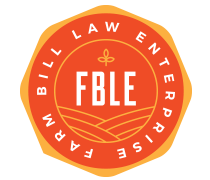Kaitlynn Dixon is a law student at the Elisabeth Haub School of Law at Pace University and a guest contributor to this blog. Organic farming was first developed in the early 1900s by agricultural researcher Sir Albert Howard, emphasizing the impact that preserving soil’s natural biome has on crop viability. As agriculture became more industrialized in the 1940s, relying heavily on chemical fertilizers…
Kipper Berven is a law student in the HLS Food Law & Policy Clinic and a guest contributor to this blog. On Tuesday, March 7th, two law students and two instructors from Harvard Law School’s Food Law and Policy Clinic traveled to Washington D.C., joining a student from the University of Pittsburgh School of Law to attend the Farmers for Climate…
Luca Greco is a law student in the HLS Food Law & Policy Clinic and a guest contributor to this blog. As Congress turns its attention to the 2023 Farm Bill, climate and conservation are among the top issues. Republicans who have generally opposed provisions aimed at addressing climate change have signaled their concern over new mandatory programs, but have signaled…
Codi Coulter is a law student at Maryland Carey School of Law and guest contributor on this blog. The Senate Committee on Agriculture, Nutrition, and Forestry held a hearing March 1 to discuss the 2023 Farm Bill’s conservation and forestry titles. Because agricultural production practices are not one-size-fits-all throughout the United States, a broad theme in the hearing revolved around…
Valerie Marshall is a law student at Duke University School of Law and guest contributor on this blog. Supporting the wide adoption of perennial agriculture is one of FBLE’s top 2023 Farm Bill recommendations to support climate change adaptation, risk management, and natural resources conservation. But above all, FBLE posits that investing in perennial agriculture would be one of the…
Interest in “regenerative agriculture” is surging as Congress starts thinking about the next farm bill. Native Americans have long cultivated food using techniques that are now widely referred to as regenerative agriculture and are leaders in its resurgence. Unlike organic agriculture, which is regulated from production to labeling by the USDA, there is no standard definition of regenerative agriculture. Rather,…
Alex Sadzewicz is a student at the University of Maryland Francis K. Carey School of Law. Nathan McMullen is a student at the University of Maryland College Park. They are both guest contributors to this blog. The Environment Quality Incentives Program (EQIP) and the Conservation Stewardship Program (CSP) are the working lands programs from the United States Department of Agriculture…
Over last weekend, the Senate pulled an all-nighter to pass the Inflation Reduction Act (IRA or the Act), narrowly getting it across the line with a 51-50 vote. If passed by the House (which may happen today), it will enact the largest U.S. investment in the fight against climate change, with some commentators saying it will “change the world” and…
Two current big ticket legislative bills – the infrastructure bill and Build Back Better – contain numerous provisions funding conservation and climate-related initiatives that would impact programs within the farm bill. These programs include forest management programs, climate adaptation initiatives, and Natural Resources Conservation Service’s (NRCS) working lands programs. While the infrastructure bill’s overlap with the farm bill’s environmental programs…
Stephanie Kelemen is a law student enrolled in the Harvard Law School Food Law & Policy Clinic and guest contributor on this blog. Buried deep in the 2018 Farm Bill, under the Conservation title, Congress established a peculiar program with $75m of mandatory funding: the Feral Swine Eradication and Control Pilot Program. Prior to encountering this Section, I had never…
